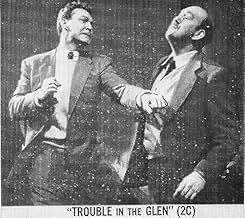Republic Pictures's biggest hit was "The Quiet Man", John Ford's Irish blarneyfest. Two years later its writer, Frank S Nugent, tried to work that magic on the Scottish Highlands. But "Trouble in the Glen" only had the prolific hack Herbert Wilcox at the helm, and his winning streak with Anna Neagle had gone phfft.
Lensed in sludgy brown Trucolor, "Trouble in the Glen" plays like an Ealing comedy sans asperity, fading quickly into the Celtic twilight from which Brigadoon rises once a century. Orson Welles is a returning laird whose years in South America presumably explain his swarthy skin tones if not his blue-grey bouffant wig. Welles was already a podgy Hollywood outcast wandering the European co-production badlands, scrounging, spending and sometimes shooting: he was between "Othello" and "Mr Arkadin" at this juncture. He relies on his magnificent organ voice and eyes that gleam in the gloom (as in "Jane Eyre") to sustain his turn as a tyrant, at odds both with his glenfolk tenantry and with a roving gang of tinkers. The head "tink" is the terminally fuddled Victor McLaglen, another Ford veteran.
Stuffing casts with faded US talent to win a Stateside circuit release was standard operating procedure for the struggling Britflick biz of the early 1950s. Besides Citizen Kane and Sgt Quincannon, "Trouble in the Glen" toplines the colourless Forrest Tucker. Like John Wayne in "The Quiet Man", Nugent makes him a Yank on a sentimental journey. Like Wayne, he banters or scraps with the locals and tames a spirited filly: Maggie Lockwood, the laird's daughter, in reality four years older than Orson! Her cut-glass accent matches neither Welles's nor the area's Scotch English. There is also a winsome, bedridden little girl for Tucker to set on her feet.
The subplot concerns unjust suspicions that the tinkers stole a deer. Has there ever been a movie in which gypsies or traveling people actually did the crimes of which they are accused?

































